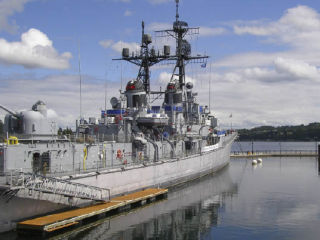Three long cylindrical guns protrude from hunched gun mounts. Smokestacks lean dockside, sporting red-painted disks that resemble eyes. Black radar antennae spike skyward from the masthead. Docked at one end of the Bremerton Boardwalk, the floating USS Turner Joy Museum, named after United States Navy Admiral Charles Turner Joy, certainly grabs the eye.
Once on board, I learn that my placid Seattle-Bremerton ferry ride across Puget Sound hasn’t begun to approximate a sailor’s experience on a warship in the Pacific.
“In the big storms, you’ll see a ship sitting right on top of a wave, and then they’ll just disappear,” says Steve Boerner, director of the USS Turner Joy Museum. Boerner has also served in the Navy (though not on the Turner Joy).
We are standing below deck in a green linoleum passageway. I sense a slight upward incline beneath my feet, though the boat sits tightly moored and calm. The Turner Joy tilts up to the front because of its hurricane bow design, Boerner explains, built for sailing in rough waters.
I have self-toured the engine room with its round gauges and switch panels, the sleeping quarters and galley (a ship’s kitchen), and admired vintage features such as the rotary dial phones and the spinning old-fashioned barber pole by the barbershop. With tight hallways, narrow hatches and steep, ladder-style stairs, it is a marvel how 350 sailors fit on board.
Boerner has stopped to talk in the narrow passageway between the sick bay and the officers’ quarters, where a framed display about the Turner Joy’s involvement in the Gulf of Tonkin incident (August 1964) — the ship was present on that fateful day which prompted U.S. escalated involvement in the Vietnam conflict — hangs on the wall. I ask Boerner if former sailors ever come back for a visit.
“Sure, guys who served come back and when they do, I pick their brains for what they know,” he says. “On the Gulf of Tonkin, I hear both ‘yeas’ and ‘nays’ about what happened. This is from guys who were there. Some say they were attacked. Others say they weren’t.”
We both pause as the weight of history sinks in. Such ambiguity is not apparent in the display. I can almost smell the sweat of the men who crewed this ship, the sailors who operated the 5-inch, 54-caliber gun mounts that were the Turner Joy’s reason for being. The gun mounts were a huge leap forward in efficiency and firepower, each mount requiring only 14 crewmen to operate. Loaded with ammunition drums carrying 20 rounds a piece, they packed fearsome rapid-fire capability.
To seal its historic role in Vietnam, the USS Turner Joy fired the very last naval round on Jan. 28, 1973, before all guns went silent at 0800 hours. A personal account (in a letter written to the museum in 1997) by Butch Brown, gun crewman on that day, tells a harrowing blow by blow “sea story” of the events leading up to the final seconds of the conflict. “We had the best crew, captain and ship in the Seventh Fleet,” he fervently concludes.
Decommissioned in 1982, the 418-foot USS Turner Joy has been restored to its Vietnam-era heyday and includes a Vietnam Prisoner of War exhibit, dedicated to all POWs of the conflict. Entering the replica of a North Vietnam prison cell, I am spooked by the head of a prisoner in the bamboo-latticed gloom. A mannequin in shackles, the captive’s clothes are thin and torn. Names of former prisoners of war are engraved on a plaque on the wall. In a nearby display of maps and model ships, a sign promises a “Narrated History of Battles in the Pacific,” but no sound plays when the button is pressed.
Volunteers of the Bremerton Historic Ships Association are gearing up to get the place in shape again for the summer months, May through September, when the ship will be open seven days a week, Boerner says. I ask him if anyone stays on the ship anymore.
“No one lives here but the seagulls and eagles,” he laughs. “Funny story; I had a tour group out on the deck, a fish drops out of the sky and hits this guy right in the face. The fish is flopping around on the deck. See, an eagle got his talons on a fish, but dropped it before he could get it to the nest.”
These days, the only overnights are scout troops and school groups. Those who spend a night on the thin mattresses of the berths get a taste of Navy life at sea: 1830 (6:30 p.m.), stow gear in berthing compartment; 1945 (7:45 p.m.), fire drill; 2230 (10:30 p.m.), “Taps.”
“The kids who stay over, they’re always asking me: Is this ship haunted? Is this ship haunted?”
Absolutely, I’m thinking.
But Boerner is talking about something else. “I say no, except for one weekend in October, that is.” Every October since 2005, local community members dust off Halloween decorations and transform the USS Turner Joy into a haunted ship to raise funds to maintain her as a memorial museum.
Stopping by the pilot house on the bridge, I overhear two visitors swapping Navy stories, the words “USS Rushmore,” “ice floes” and “radar stations” floating up from below. Reunions are held on the ship, as well as retirements and memorial services. Former servicemen bring their families back to share memories of their enlistment.
“After being in the Navy and living on a ship, it’s really strange to lock the doors and walk away at night,” Boerner says.
I look up, hoping to see an eagle.



